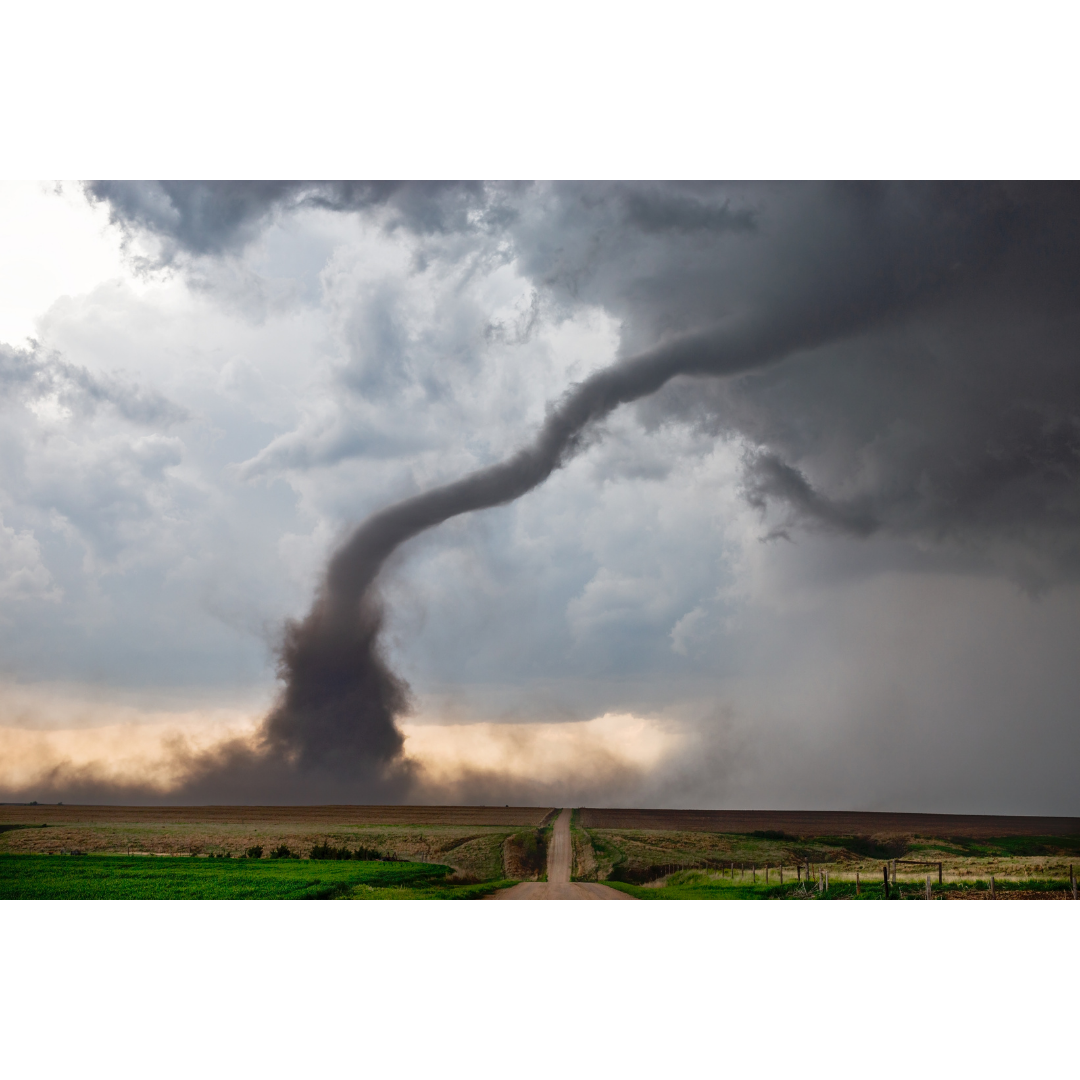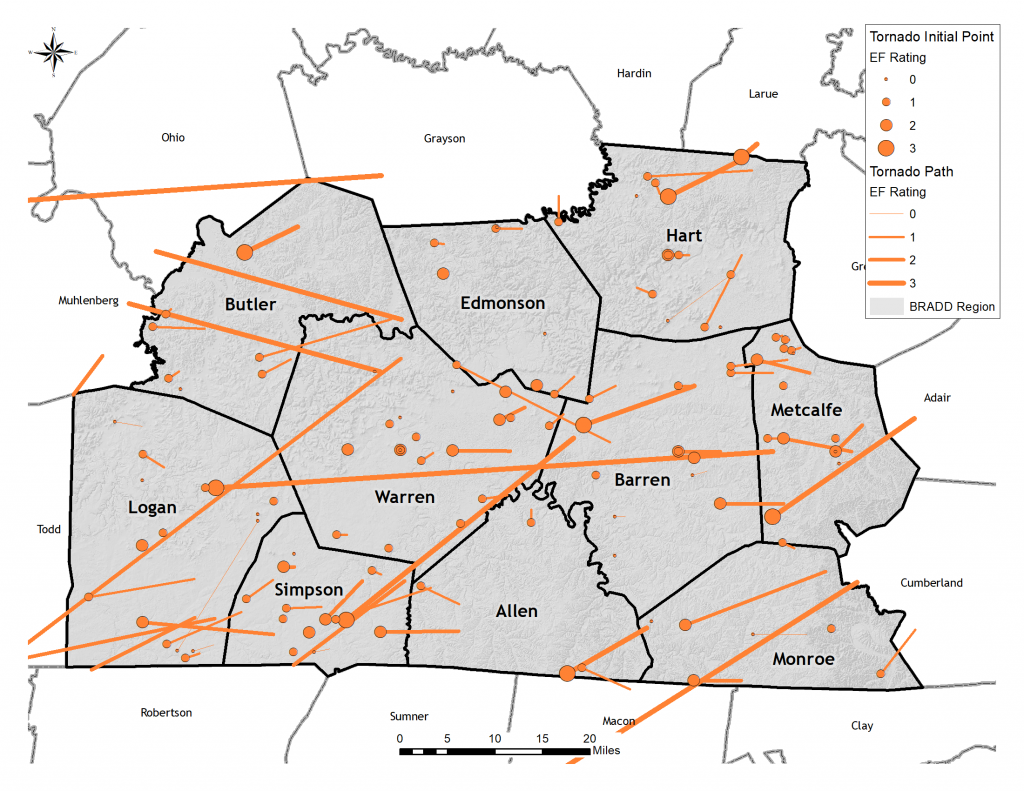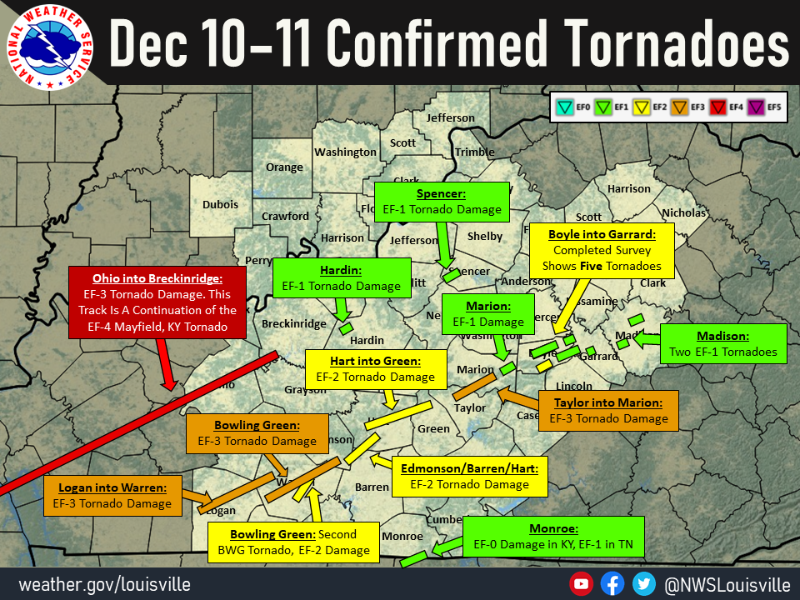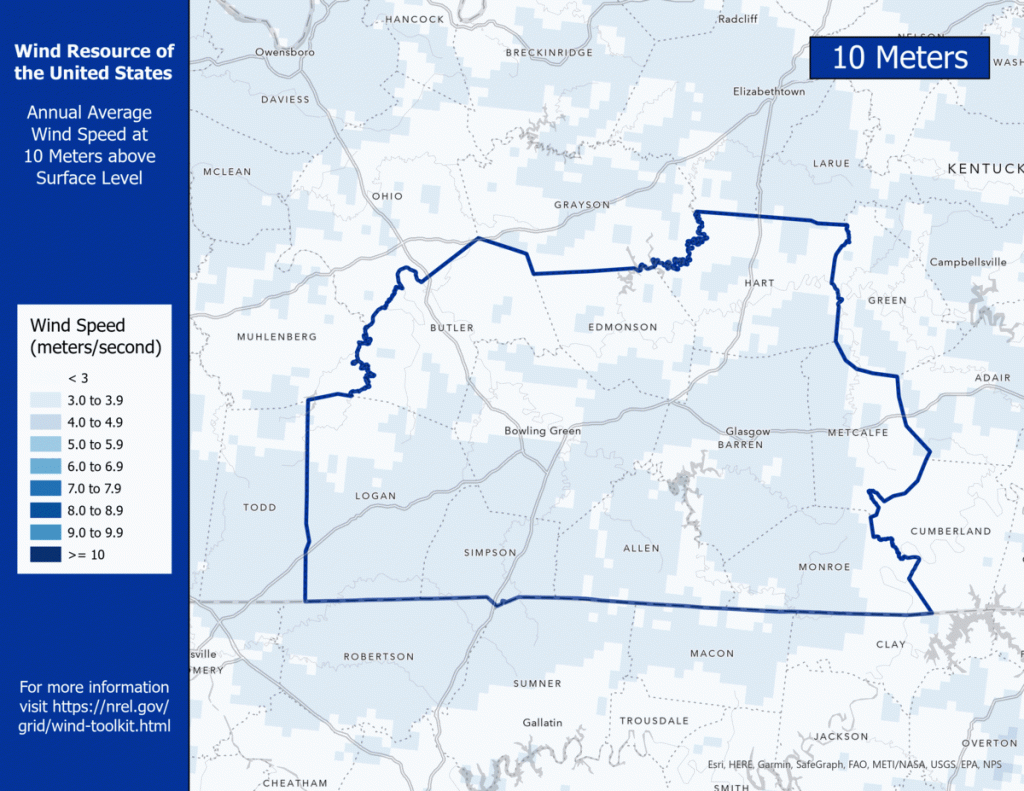
 Tornado
Tornado
A tornado is most commonly defined as violently rotating column of air within the updraft region of thunderstorms. Tornadoes are usually sighted as a funnel or cone-like shape trailed by a cloud of dust and debris close to the ground. They generally occur near the trailing edge or end of a thunderstorm. These systems can follow tropical storms and hurricanes as well as they move inland. Tornadoes occur when cool air from a storm converges with the warm air, causing the warm air to rise and from the shape of a funnel. Peak tornado season ranges from March-May in the majority of southern states usually occurring between the hours of 3PM and 9PM. However, tornadoes can occur during any month of the year and at most any time during the day.
Background & Extent
Tornado Classification
The Fujita-Pearson Tornado Measurement Scale measures the magnitude of a tornado by the seriousness of the damage caused and the strength of the wind speed produced during the tornado. The scale was originally developed by a University of Chicago storms research scientist Dr. Ted Fujita. At the time of development there was no way to accurately measure wind speed, so Dr. Fujita developed a scale where approximations can be made based on the amount of damage done. The scale rates tornadoes based on damage done to an individual structure on a scale ranging from F0 (little damage) to F5 (blown away). After the Fujita Scale rose to prominence, many scientists and engineers noted that the scale had several weaknesses because it did not recognize difference in construction and it overestimated wind speeds greater than an F3.
The Enhanced Fujita (EF) Scale was thus developed by meteorologists and engineers to expand and improve upon the work done by Dr. Fujita based on years of observation. The table information includes wind speed and description of damage done for each rating on the EF scale.
EF-O: Wind Speed of 65-85mph; Light damage. Peels surface off some roofs; some damage to gutters or siding; branches broken off trees; shallow-rooted trees pushed over.
EF-1: Wind Speed of 86-110mph; Moderate damage. Roofs severely stripped; mobile homes overturned or badly damaged; loss of exterior doors; windows and other glass broken.
EF-2: Wind Speed of 111-135mph; Considerable damage. Roofs torn off well-constructed houses; foundations of frame homes shifted; mobile homes completely destroyed; large trees snapped or uprooted; light-object missiles generated; cars lifted off ground.
EF-3: Wind Speed of 136-165mph; Severe damage. Entire stories of well-constructed houses destroyed; severe damage to large buildings such as shopping malls; trains overturned; trees debarked; heavy cars lifted off the ground and thrown; structures with weak foundations blown away some distance
EF-4: Wind Speed of 166-200mph; Devastating damage. Whole frame houses and well-constructed houses completely leveled; cards thrown and small missiles generated.
EF-5: Wind Speed of over 200mph; Incredible damage. Strong frame houses leveled off foundations and swept away; automobile-sized missiles fly through the air in excess of 100 m (109 yards); high-rise buildings have significant structural deformation; incredible phenomena will occur.
Past Events, Location, & Extent
Between 2000 and 2021, the BRADD Region received — FEMA Disaster Declarations that included tornados:
The map below covers tornados that happened in the region from 1950-2020. While not each of these events received a FEMA declaration, each qualified as a tornado.

Historical Occurrences
In December 2021 and January 2022, the BRADD region experienced multiple tornados of record. A summary of those events and how they impacted jurisdictions in the BRADD region is below.
December 10-11 Tornadoes

A potent storm system moved across the central United States on December 10-11, 2021 resulting in widespread severe weather. Numerous tornadoes occurred with storms that traveled through Kentucky Friday evening into Saturday morning (Dec 10-11) including a significant long track tornado that devastated Mayfield, KY. This tornado began near Woodland Mills, Tennessee, and stayed on the ground all the way to Falls of Rough, Kentucky; a distance of 165.7 miles (weather.gov).
The tornado became more elevated hitting several trees, power lines, and there was some apartment roofing damage near the Barren River. The tornado crossed interstate 65 near the 27 mile marker and was about 200 yards wide.
There was extensive tree damage and one barn was destroyed east of the interstate between Cumberland Trace Road and Porter Pike. Winds were between 90 and 100 mph, and then the tornado increased to EF2 120 mph striking the Corvette track and Motorsports Park. There was extensive damage to the main building and a series of garage and storage buildings had extensive structural damage to the individual roofs. Debris was thrown over half a mile to the east northeast. The tornado was 225 yards wide, and the survey team could see the main tornado damage about a half a mile away towards the Corvette plant on the other side of the interstate. NWS used drone technology to analyze the roofing structures for wind speed determinations.
The tornado weakened and paralleled Interstate 65 along McGinnis Road and Bristow Rd. Most of the damage was trees snapped, twisted, and uprooted facing from the northwest to the southeast direction. There was also some siding, gutter, and roofing damage. The tornado was between 100 and 150 yards wide and the wind speeds were around 90 to 95 mph before it lifted at the 29.2 mile marker.
January 1, 2022 Tornadoes.
During New Year’s Eve into New Year’s Day, active weather was observed across Kentucky as several waves of low pressure moved along a frontal boundary that was stalled out across the region. This resulted in multiple rounds of widespread precipitation, and rainfall amounts of 2 to 4 inches with locally higher amounts were observed across the area. As the boundary lifted north as a warm front New Year’s Day, strong to severe storms were able to develop within the warm sector ahead of an approaching cold front, with multiple tornadoes and scattered straight-line wind damage being observed (weather.gov).
NWS Storm Survey Teams found an area of straight line winds of 70 to 75 mph, beginning at the Hunting Creek subdivision off of Cave Mill Road. Along Cave Mill Road fences were blown down, minor shingle damage to homes occurred, and many pine and cedar trees were snapped and topped.
At the intersection of Curtis and Cave Mill Rd, there was a change in the damage pattern. The damage became more concentrated with gutters, shingles, roof, and soffit damage. Trees were snapped and uprooted facing to the north, northeast, and east southeasterly direction. Clear evidence was found of a weak tornado that formed with winds estimated between 80 and 85 mph. The tornado was slightly elevated off the ground and was very intermittent.
The tornado lifted just before the Marriott TownePlace Suites on Cave Mill Rd, and then there was sporadic straight-wind damage all the way to Ashton Parc Apartments off of Shive Lane. Thornton Furniture had the most damage from the straight-line winds with roofing and facade damage.
Read More at: https://www.wbko.com/2022/01/02/nws-confirms-tornado-hit-south-side-bowling-green-new-years-day/#:~:...,line%20winds%20to%2075%20mph
The tornado continued along rural open farm fields before damaging a mix of hard and softwood trees. Some trees had large limbs downed, while others had snapped trunks along Kenny Stratton Road west of Lickskillet. The tornado ended at around 12:21 PM EST along with no further damage observed past Olmstead Road.
An EF-1 tornado hit around the Omstead/Russellville area. This confirmed tornado was a continuation of the parent circulation that caused the tornado southwest of Olmstead KY that crossed the Todd/Logan county line. After a gap of more than 2 miles, the tornado redeveloped and caused damage along Watermelon Road. Minor roof damage occurred near this location. The tornado continued along JB Shackelford Road in mostly rural open farm fields before damage occurred along Johnson Young Road (Route 739). Several trees had large limbs down, and a hardwood tree was uprooted nearby. The strongest damage occurred as a nearby barn was completely demolished with estimated wind speeds at 110 mph for strong EF-1 winds.
The tornado then turned to the northeast causing minor damage to a porch covering at BL Shackelford Road. Damage continued toward Williams Store where significant tree damage occurred with several large trees either snapped or had large branches broken. The tornado then crossed rural areas west of Nashville Road (Highway 431).
At Nashville Road, a barn had roof damage observed with another outbuilding shifted off the foundation. At this point, the tornado appeared to strengthen with consistent damage just north of Ellis Road. A barn had a silo completely destroyed with major damage to 2 other silos, and drone footage confirmed several trees uprooted with branches snapped beyond this barn. The tornado then did some damage along Ellis road with roof damage observed at another barn.
An isolated tree snap occurred near the junction of Franklin Road (route 100) and Airport Road before the tornado crossed rural fields near the Russellville-Logan County Airport. The tornado continued to the northeast with damage observed to the west of Dennis Corinth Road to trees and barns.
Along Highway 90, the tornado increased to a width of 125 yards with many barns incurring structural roof damage. At the Legacy Dairy Farms, an older 40 x 60ft barn was destroyed and there was sidewall damage to a large grain silo along Goodnight-Hiseville Road. Winds in this area were 85 mph.
Along Route 740, the tornado paralleled the road and the width increased to 150 yards. In Hiseville, there was barn damage with half a dozen barns sustaining significant structural damage. A 50ft diameter well-built grain silo was twisted and knocked over, and numerous trees were twisted, snapped, or uprooted. Most of the trees were facing north, northeast, east, and a few in the southeasterly direction. At the Hiseville Cemetery, modern and older gravestones were knocked over and cedar trees were knocked over and topped.
Probability
Occurrence
Between 2000 and 2021 (21 years), the BRADD Region experienced 68 tornadoes.
- Allen County: 7 tornadoes/21 years =33% chance of a tornado happening in a given year.
- Barren County: 7 tornadoes/21 years= 33% chance of a tornado happening in a given year.
- Butler County: 4 tornadoes/21 years= 19% chance of a tornado happening in a given year.
- Edmonson County: 6 tornadoes/21 years=29% chance of a tornado happening in a given year.
- Hart County: 7 tornadoes/21 years=33% chance of a tornado happening in a given year.
- Logan County: 7 tornadoes/21 years=33% chance of a tornado happening in a given year.
- Metcalfe County: 8 tornadoes/21 years=38% chance of a tornado happening in a given year.
- Monroe County: 8 tornadoes/21 years=38% chance of a tornado happening in a given year.
- Simpson County: 6 tornadoes/21 years=28.5% chance of a tornado happening in a given year.
- Warren County: 9 tornadoes/21 years=43% chance of a tornado happening in a given year.
Wind Zone
The BRADD Region exists in the highest wind zone in the United States, zone IV, which translates to a threat of winds up to 250 miles per hour during a severe storm. This is the highest classification of wind zones and signifies the greatest tornado threat. The BRADD Region experiences the highest threat level for tornadoes during the spring months of April, May, and June; but as witnessed in December 2021, tornados can occur at any point in the year with the right conditions.

Draxl, C., B.M. Hodge, A. Clifton, and J. McCaa. 2015. “The Wind Integration National Dataset (WIND) Toolkit.” Applied Energy 151: 355366.
Lieberman-Cribbin, W., C. Draxl, and A. Clifton. 2014. Guide to Using the WIND Toolkit Validation Code (Technical Report, NREL/TP-5000-62595). Golden, CO: National Renewable Energy Laboratory.
King, J., A. Clifton, and B.M. Hodge. 2014. Validation of Power Output for the WIND Toolkit (Technical Report, NREL/TP-5D00-61714). Golden, CO: National Renewable
Climate Change
The affect that climate change has on tornadoes is difficult to study because tornadoes occur on a small scale and the variability of frequency, which makes it difficult to tease out any significant trends. However, a 2015 empirical study published in Climate Dynamics founds changes in tornado climatology due to climate change. The researchers studied the annual number of days with multiple tornadoes against the ratio of days with only one tornado. This data showed that there has been a decrease in the number of days with at least one tornado and an increase in days with multiple tornadoes, or an increase in tornado clusters. The explanation given to this change was that climate change has increased the number of days conducive to severe storms and tornadoes through increases in convective available potential energy (CAPE). Essentially, global warming has increased the overall temperature of the atmosphere and has affected local-scale thermodynamics. As air warms and rises, it carries moisture to higher altitudes. Vertical wind shear comingles with The research conducted by Stanford indicated that global warming has increased the number of days that produce CAPE (CAPE) with sufficient vertical wind shear to form severe storms. In essence, climate change increases the likelihood that severe storms will occur by creating the conditions for a storm more often.
Overall Probability
Overall, the BRADD Region experiences a high probability of a tornado event for the region as due to the frequency of past events, its wind zone classification, and as outlined using the classification definitions from FEMA.
Impact & Vulnerability
Tornadoes can be incredibly devastating to a community and can cause significant property damage and lead to injuries and loss of life.
Mobile Homes
Residents of mobile homes are particularly vulnerable to tornado events because mobile homes lack a foundation and use weak building materials. BRADD used 2019 ACS data to create a map that displays mobile home density by census tract. The percent of mobile homes by census tract ranges from 0% in Census Tract 105 in Warren County to 49.1% in Census Tract 9302 in Butler County.
To view specific data on the number and percent of housing units that are mobile homes, click on a census tract.
Residential and commercial impact includes: damage to and destruction of buildings, loss of trees and landscaping, damage to and destruction of automobiles, trucks, and airplanes, disruptions to local utilities and services (power, communications, drinking water, and transportation).
Tornadoes can cause death and injuries.
Economy
Social and economic disruption could be temporary. The community will experience revenue loss due to loss in production and industry.
Hazard Vulnerability Summary Analysis
Click the county names below to review vulnerability analysis by county. Overall vulnerability is defined using the classification definitions from FEMA.
- Between 2000 and 2021, Allen County has experienced 7 tornadoes/21years =33% chance of a tornado happening in a given year.
- Since 1950, tornadoes that touched down in Allen County have caused 11 injuries and 4 deaths.
- Allen County contains two census tracts wherein at least 25% of all housing units are mobile homes.
Because of these factors, Allen County experiences moderate vulnerability to tornadoes. Scottsville reflects Allen County’s overall history of severe storms, and therefore experiences moderate vulnerability as well.
- Between 2000 and 2021, Barren County has experienced 7 tornadoes/21years =33% chance of a tornado happening in a given year.
- Since 1950, tornadoes that touched down in Barren County have caused 51 injuries and 3 deaths.
- Barren County contains two census tracts wherein at least 25% of all housing units are mobile homes.
Because of these factors, Barren County experiences moderate vulnerability to tornadoes. Cave City, Glasgow, and Park City reflect Barren County’s overall history of tornado events, and therefore experience moderate vulnerability as well.
- Between 2000 and 2021, Butler County has experienced 4 tornadoes/21years =19% chance of a tornado happening in a given year.
- Since 1950, tornadoes that touched down in Butler County have caused 1 injury and 1 death.
- Butler County contains one census tract wherein at least 25% of all housing units are mobile homes.
Because of these factors, Butler County experiences moderate vulnerability to tornadoes. Morgantown, Rochester, and Woodbury reflect Butler County’s overall history of tornado events, and therefore experiences moderate vulnerability as well.
- Between 2000 and 2021, Edmonson County has experienced 6 tornadoes/21years =29% chance of a tornado happening in a given year.
- Since 1950, tornadoes that touched down in Edmonson County have caused 2 injuries and 0 deaths.
- Edmonson County contains four census tracts wherein at least 25% of all housing units are mobile homes.
Because of these factors, Edmonson County experiences moderate vulnerability to tornadoes. Brownsville reflects Edmonson County’s overall history of tornado events, and therefore experiences moderate vulnerability as well.
- Between 2000 and 2021, Hart County has experienced 7 tornadoes/21years =33% chance of a tornado happening in a given year.
- Since 1950, tornadoes that touched down in Hart County have caused 22 injuries and 1 death.
- Hart County contains two census tracts wherein at least 25% of all housing units are mobile homes.
Because of these factors, Hart County experiences moderate vulnerability to tornadoes. Bonnieville, Horse Cave, and Munfordville reflect Hart County’s overall history of tornado events, and therefore experience moderate vulnerability as well.
- Between 2000 and 2021, Logan County has experienced 7 tornadoes/21years =33% chance of a tornado happening in a given year.
- Since 1950, tornadoes that touched down in Logan County have caused 23 injuries and 2 deaths.
- Logan County does not contain any census tracts wherein at least 25% of all housing units are mobile homes.
Because of these factors, Logan County experiences moderate vulnerability to tornadoes. Adairville, Auburn, Lewisburg, and Russellville all reflect Logan County’s overall history of tornado events, and therefore experience moderate vulnerability as well.
- Between 2000 and 2021, Metcalfe County has experienced 8 tornadoes/21years =33% chance of a tornado happening in a given year.
- Since 1950, tornadoes that touched down in Metcalfe County have caused 7 injuries and 3 deaths.
- Metcalfe County does not contain any census tracts wherein at least 25% of all housing units are mobile homes.
Because of these factors, Metcalfe County experiences high vulnerability to tornadoes. Edmonton reflects Metcalfe County’s overall history of tornado events, and therefore experiences high vulnerability as well.
- Between 2000 and 2021, Monroe County has experienced 8 tornadoes/21 years = 33% chance of a tornado happening in a given year.
- Since 1950, tornadoes that touched down in Monroe County have not caused injury or death.
- Monroe County contains one census tract wherein at least 25% of all housing units are mobile homes.
Because of these factors, Monroe County experiences high vulnerability to tornadoes. Fountain Run, Gamaliel, and Tompkinsville all reflect Monroe County’s overall history of tornado events, and therefore experience high vulnerability as well.
- Between 2000 and 2021, Simpson County has experienced 6 tornadoes/21years =28.5% chance of a tornado happening in a given year.
- Since 1950, tornadoes that touched down in Simpson County have caused 13 injuries and 1 death.
- Simpson County does not contain any census tracts wherein at least 25% of all housing units are mobile homes.
Because of these factors, Simpson County experiences moderate vulnerability to tornadoes. Franklin reflects Simpson County’s overall history of tornado events, and therefore experiences moderate vulnerability as well.
- Between 2000 and 2021, Warren County has experienced 9 tornadoes/21years =43% chance of a tornado happening in a given year.
- Since 1950, tornadoes that touched down in Warren County have caused 51 injuries and 2 deaths.
- Warren County contains one census tract wherein at least 25% of all housing units are mobile homes.
Because of these factors, Warren County experiences high vulnerability to tornadoes. Bowling Green, Plum Springs, Oakland, Smiths Grove, and Woodburn all reflect Warren County’s overall history of tornado events, and therefore experience high vulnerability as well.